Aerial Yoga Retreat in India
Join us for a Transformative Aerial Yoga Retreat in India
Immerse yourself in five days of deep relaxation and rejuvenation as we delve into the world of Aerial Yoga Retreat in India in the serene beaches of Goa.
Aerial Yoga Retreat in India: Elevating Your Yoga Practice to New Heights
Introduction to Aerial Yoga Retreat
In recent years, the practice of yoga has taken on many innovative forms, one of the most exciting being aerial yoga. Combining traditional yoga poses with acrobatics and aerial arts, aerial yoga offers a unique and exhilarating way to deepen your practice while defying gravity. With the rising popularity of yoga retreats, it’s no wonder that aerial yoga retreats have become sought-after experiences for yogis around the world.

Why Aerial Yoga Retreat in India ?
Aerial yoga retreats in India offer a unique and transformative experience that combines the ancient wisdom of yoga with the exhilarating practice of aerial suspension. Here are several reasons why aerial yoga retreats in India are a popular choice:
1. Rich Yogic Heritage:
- India is the birthplace of yoga, with a rich and diverse tradition that dates back thousands of years. Practicing aerial yoga in India allows participants to connect with the roots of yoga and experience the authentic teachings of this ancient practice in its cultural homeland.
2. Spiritual Significance:
- India is renowned for its spiritual atmosphere and sacred sites, making it an ideal destination for those seeking inner peace and self-discovery. Aerial yoga retreats in India often incorporate meditation, chanting, and spiritual teachings, providing a holistic experience for body, mind, and soul.
3. Serene Natural Settings:
- From the majestic Himalayas to the tranquil beaches of Goa, India offers a diverse array of landscapes and environments that provide the perfect backdrop for aerial yoga practice. Retreat centers are often nestled amidst lush greenery, overlooking scenic vistas, or situated near sacred rivers and mountains, creating a serene and rejuvenating atmosphere for practice and contemplation.
4. Experienced Instructors:
- Many aerial yoga retreats in India are led by experienced instructors who have received extensive training in both yoga and aerial arts. These instructors bring a wealth of knowledge, skill, and expertise to their teaching, ensuring that participants receive safe and effective instruction in aerial yoga practice.
5. Community and Connection:
- Aerial yoga retreats in India provide an opportunity for participants to connect with like-minded individuals from around the world who share a passion for yoga and wellness. The supportive and nurturing environment of a retreat fosters a sense of community and camaraderie, allowing participants to form lasting friendships and support each other on their journey of self-discovery.
6. Personal Transformation:
- Aerial yoga retreats in India offer a space for personal transformation and growth, allowing participants to deepen their yoga practice, overcome challenges, and explore new dimensions of movement and awareness. Whether seeking physical strength, mental clarity, or spiritual awakening, participants often find that a retreat in India provides the perfect environment for inner transformation and renewal.
7. Cultural Immersion:
- In addition to yoga practice, aerial yoga retreats in India often include opportunities for cultural immersion and exploration. Participants may have the chance to visit nearby temples, attend traditional ceremonies, or engage in cultural activities, providing a deeper understanding of India’s rich cultural heritage and spiritual traditions.
Overall, aerial yoga retreats in India offer a unique blend of yoga, adventure, and spiritual exploration that appeals to practitioners seeking a transformative and unforgettable experience. Whether embarking on a solo journey of self-discovery or joining a group retreat with friends or family, participants often return home feeling refreshed, inspired, and empowered to continue their yoga journey with renewed passion and purpose.
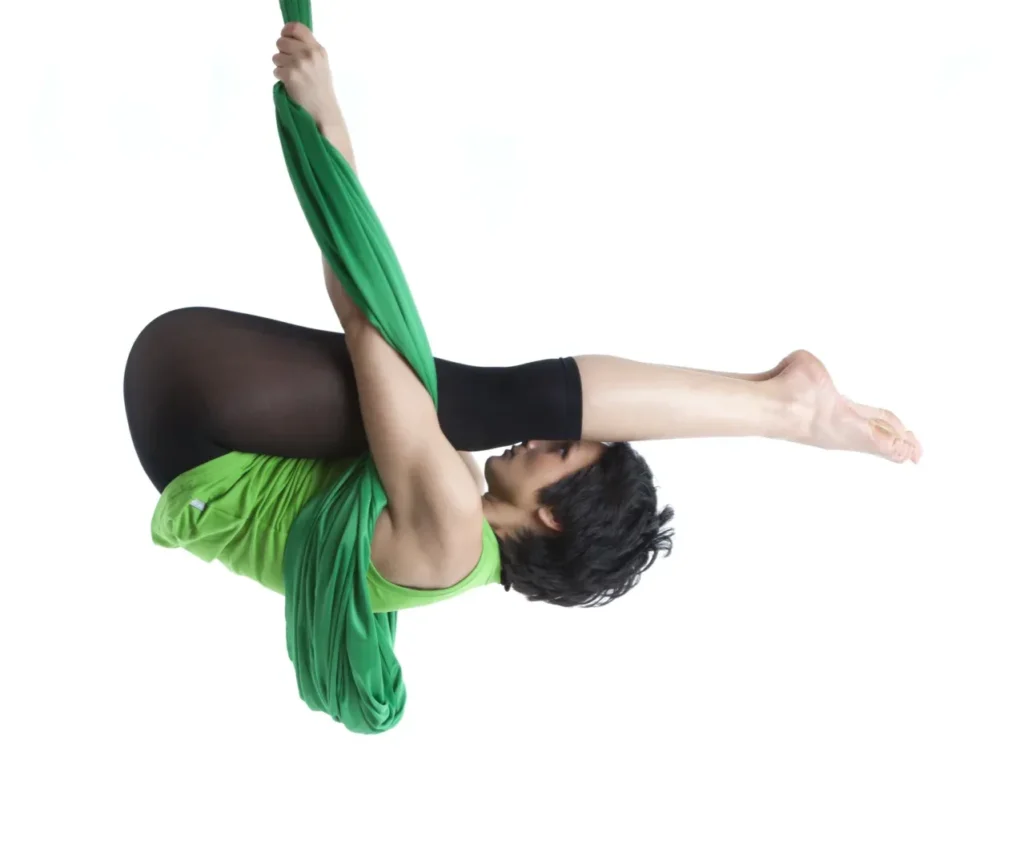
What is aerial yoga
Aerial yoga, also known as anti-gravity yoga or aerial hammock yoga, is a unique and dynamic form of yoga that incorporates elements of traditional yoga, Pilates, and aerial acrobatics. In aerial yoga, practitioners perform yoga poses while suspended in a soft fabric hammock or swing, which is securely attached to the ceiling or a supportive structure.
The hammock acts as a prop to support and assist practitioners in achieving traditional yoga poses, as well as allowing for a wider range of motion and deeper stretches. By using the hammock to support some or all of their body weight, practitioners can explore new dimensions of movement and challenge themselves in ways that may not be possible in a traditional yoga practice on the mat.
Aerial yoga classes typically include a combination of flowing sequences, inversions, and stretches, all performed with the support of the hammock. Inversions, such as downward-facing dog or handstand, are a key feature of aerial yoga and offer unique benefits, such as spinal decompression and increased blood flow to the brain.
One of the distinguishing features of aerial yoga is its playful and creative approach to movement. Practitioners have the freedom to explore and experiment with different poses and transitions, using the hammock as a tool for self-expression and artistic expression. This sense of freedom and exploration can be both empowering and exhilarating, making aerial yoga a fun and engaging practice for practitioners of all levels.
In addition to its physical benefits, aerial yoga also offers mental and emotional benefits, such as stress reduction, increased mindfulness, and a sense of lightness and freedom. Many practitioners find that the experience of being suspended in the air fosters a sense of childlike wonder and joy, helping them to reconnect with their inner sense of playfulness and creativity.
Overall, aerial yoga is a versatile and transformative practice that combines elements of strength, flexibility, balance, and mindfulness, offering practitioners a unique and exhilarating way to deepen their yoga practice and explore new horizons of movement and self-discovery. Whether you’re a seasoned yogi looking to spice up your practice or a curious beginner eager to try something new, aerial yoga has something to offer for everyone.
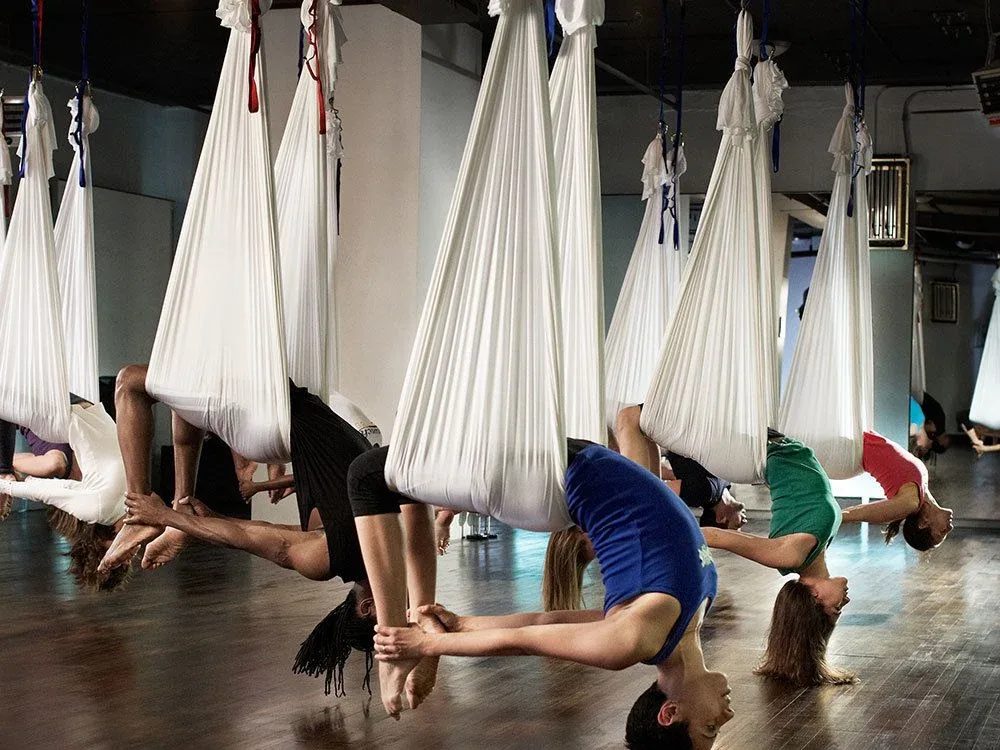
Benefits of Aerial Yoga
Physical Benefits
Enhanced Flexibility: Aerial yoga allows for deeper stretches and greater range of motion than traditional yoga, as the hammock supports and assists in achieving challenging poses.
Increased Strength: Engaging muscles to stabilize and maneuver within the hammock builds upper body, core, and leg strength, leading to improved muscle tone and endurance.
Spinal Decompression: Inverted poses in aerial yoga gently elongate the spine, relieving compression and tension, which can alleviate back pain and improve posture.
Improved Balance and Coordination: Balancing in the hammock challenges proprioception and coordination, enhancing balance skills and overall body awareness.
Mental Benefits
Stress Reduction: The rhythmic movement and deep breathing in aerial yoga promote relaxation and reduce cortisol levels, helping to alleviate stress and anxiety.
Mood Enhancement: Aerial yoga releases endorphins, the body’s natural mood-boosting chemicals, leaving practitioners feeling uplifted and rejuvenated after each session.
Increased Focus and Concentration: Concentrating on maintaining stability in aerial poses requires mental focus, improving attention and cognitive function over time.
Mindfulness Practice: Aerial yoga encourages present-moment awareness and mindfulness as practitioners flow through poses with intention and breath awareness.
Spiritual Benefits
Heightened Self-Awareness: Aerial yoga provides a unique perspective from which to observe thoughts, emotions, and sensations, fostering self-reflection and introspection.
Connection with Breath: Syncing movement with breath in aerial yoga cultivates a deep connection to the breath, facilitating a sense of inner calm and centeredness.
Elevated Consciousness: Inverting the body in aerial yoga stimulates circulation and oxygenation to the brain, promoting mental clarity and expanded consciousness.
Connection to Universal Energy: Practicing aerial yoga in a suspended hammock creates a sense of weightlessness and freedom, fostering a deeper connection to the energy of the universe and one’s own inner wisdom.
Aerial yoga boasts a myriad of benefits for the body, mind, and spirit. From increased flexibility and strength to improved mental clarity and emotional well-being, the advantages of practicing yoga in the air are truly transformative. Physically, aerial yoga challenges the body to engage muscles in new ways, leading to enhanced muscle tone and increased circulation. Mentally, the playful nature of aerial yoga encourages a sense of childlike wonder and joy, helping practitioners to release stress and cultivate mindfulness. Spiritually, the feeling of weightlessness allows yogis to connect more deeply with their breath and inner selves, fostering a sense of peace and harmony.
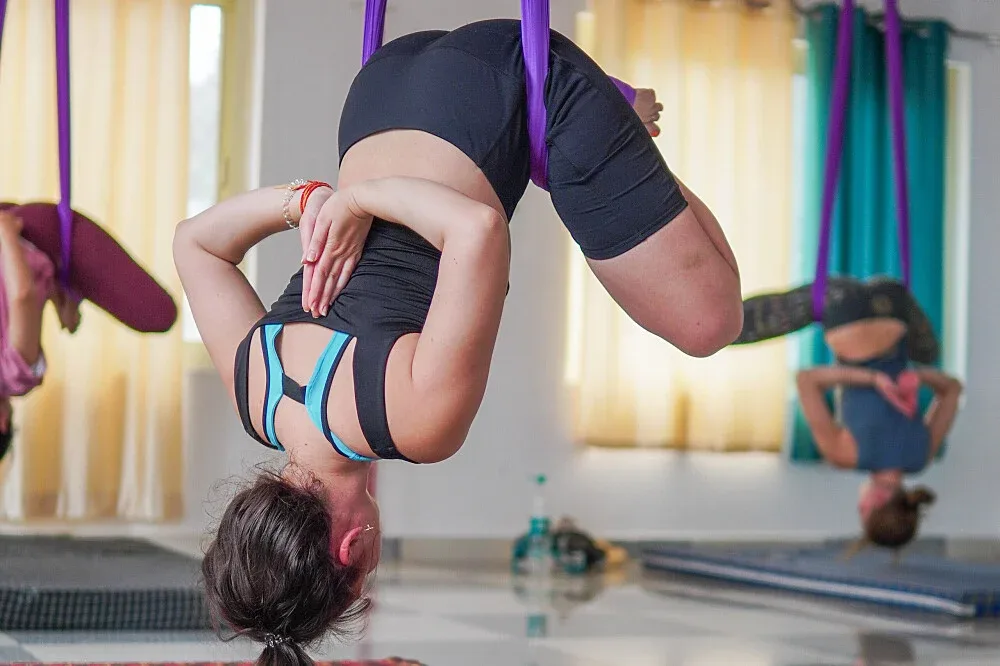
Preparing for an Aerial yoga retreat in India
Embarking on an aerial yoga retreat requires careful preparation to ensure a safe and enjoyable experience. Physically, it’s important to build strength and flexibility in the weeks leading up to the retreat, focusing on core stability and upper body strength. Mentally, setting intentions and goals for your practice can help you get the most out of your retreat experience. And don’t forget to pack essentials such as comfortable yoga attire, a sturdy water bottle, and sunscreen to protect against the Indian sun.
What to Expect
Upon arriving at your chosen retreat center, you can expect to be greeted with warm hospitality and a sense of serenity. Daily schedules typically include a mix of aerial yoga classes, meditation sessions, and free time for exploring the surrounding area. Classes may range from beginner-friendly introductions to advanced workshops for seasoned practitioners, ensuring that there’s something for everyone. In addition to yoga, many retreats offer…
additional activities such as hiking, sightseeing, or cultural excursions, allowing you to immerse yourself fully in the local culture and landscape.
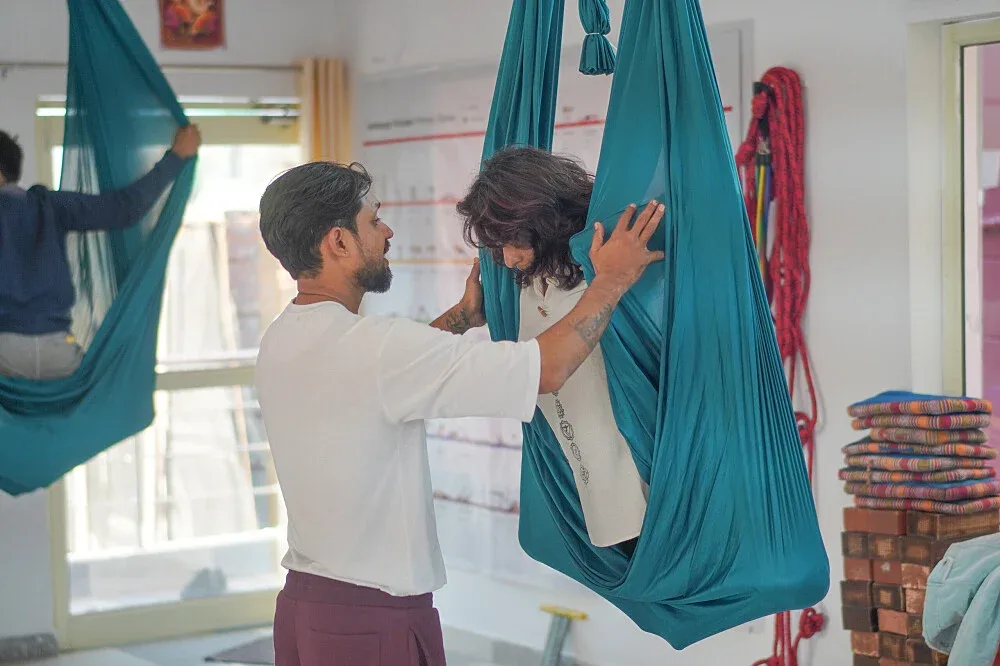
Safety Precautions
While aerial yoga can be a thrilling and exhilarating experience, it’s important to prioritize safety at all times. Before participating in any aerial yoga class or workshop, be sure to listen carefully to the instructions provided by qualified instructors and follow proper techniques to avoid injury. It’s also essential to be aware of your own physical limitations and to communicate any concerns or discomfort to your instructor. By practicing mindfulness and staying attuned to your body, you can enjoy the benefits of aerial yoga while minimizing the risk of accidents.
1. Qualified Instruction:
Ensure that you receive instruction from a qualified and certified aerial yoga instructor who has received proper training in rigging and spotting techniques.
Beginners should start with introductory classes to learn basic poses and safety protocols before progressing to more advanced maneuvers.
2. Proper Equipment Inspection:
Before each session, thoroughly inspect the aerial hammock, rigging points, and any other equipment for signs of wear, tear, or damage.
Check that the hammock is securely attached to the rigging points and that all knots are properly tied and tightened.
3. Warm-Up and Cool Down:
Begin each session with a gentle warm-up to prepare the body for aerial yoga practice, focusing on loosening tight muscles and joints.
Conclude each session with a cool-down period to stretch and relax the muscles, aiding in recovery and reducing the risk of injury.
4. Proper Alignment and Technique:
Pay close attention to proper alignment and technique in each aerial yoga pose to avoid strain or injury.
Listen to your body and modify poses as needed to accommodate your individual flexibility and strength levels.
5. Avoid Overexertion:
Pace yourself during aerial yoga practice and avoid pushing beyond your limits, especially when attempting advanced poses.
Take breaks as needed and rest if you feel fatigued or dizzy to prevent overexertion and potential injury.
6. Mindful Movement:
Practice mindfulness and focus on your breath while moving through aerial yoga poses to maintain awareness of your body and surroundings.
Avoid sudden or jerky movements that could destabilize the hammock or lead to loss of balance.
7. Listen to Your Body:
Honor your body’s limitations and avoid pushing through pain or discomfort during aerial yoga practice.
If you experience any sharp or shooting pain, dizziness, or discomfort, stop immediately and seek guidance from your instructor.
8. Spotting and Assistance:
When attempting new or challenging poses, have a spotter or instructor nearby to provide assistance and ensure safety.
Communicate openly with your instructor about any concerns or limitations you may have, so they can provide appropriate support and guidance.
. Airplane Pose (Savasana Variation):
Lie back in the hammock with arms extended out to the sides.
Lift the legs and torso off the ground, creating a flying or “airplane” shape with the body.
Engage the core and balance in the hammock, feeling a sense of lightness and freedom.
2. Floating Forward Fold:
Sit in the hammock with legs extended and feet flexed.
Lean forward, allowing the hammock to support the weight of the torso as you fold forward.
Relax the spine and breathe deeply, feeling a gentle stretch in the hamstrings and lower back.
3. Spider Pose:
Stand facing the hammock with hands resting on the fabric.
Walk the feet back and lean forward, allowing the body to hang freely with arms extended overhead.
Spread the fingers wide and press into the palms, feeling a stretch in the shoulders and upper back.
4. Inverted Pigeon Pose:
Begin in a seated position with one leg extended and the other knee bent, foot resting in the hammock.
Lean back and extend the arms overhead, using the hammock for support as you recline.
Feel a deep stretch in the hip flexors and quadriceps of the extended leg.
5. Flying Splits:
Start in a standing position with one foot in the hammock and the other foot grounded.
Lift the grounded foot off the floor, extending the leg straight out in front of you.
Use the hammock for support as you deepen the stretch in the hamstrings and hip flexors.
6. Star Pose:
Sit in the hammock with legs extended wide and arms outstretched to the sides.
Lean back, allowing the hammock to support the weight of the body as you open the chest and hips.
Engage the core and breathe deeply, feeling a sense of expansion and openness in the body.
7. Flying Pigeon Pose:
Begin in a seated position with one foot in the hammock and the other foot grounded.
Bend the grounded knee and place the ankle on the opposite thigh, coming into a seated pigeon pose.
Use the hammock for support as you lean forward, deepening the stretch in the hip of the grounded leg.
8. Cocoon Pose:
Sit in the hammock with knees drawn towards the chest and arms wrapped around the legs.
Gently rock back and forth, allowing the hammock to cradle and support the body like a cocoon.
Close the eyes and focus on the breath, feeling a sense of relaxation and surrender.
These are just a few examples of the many aerial yoga poses that practitioners can explore. Each pose offers its own unique benefits for the body, mind, and spirit, helping to cultivate strength, flexibility, balance, and inner peace. Whether you’re a beginner or an experienced yogi, aerial yoga poses provide a fun and engaging way to deepen your practice and discover new possibilities in the air.
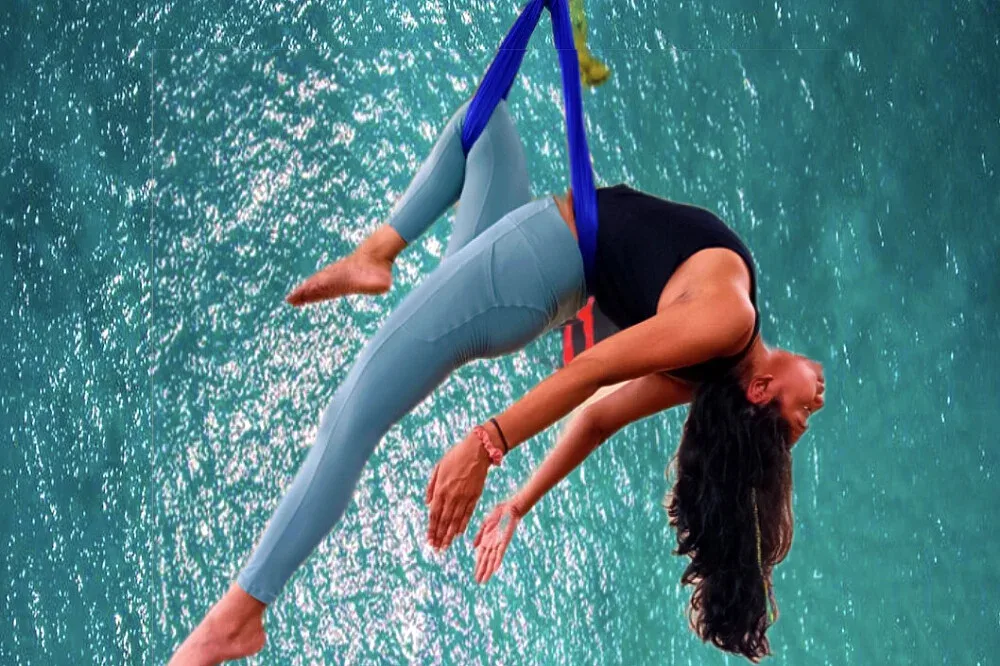
is it safe to do aerial yoga at home?
While aerial yoga can be a rewarding and enjoyable practice, it’s important to approach it with caution, especially if you’re considering practicing at home. Here are some factors to consider when deciding whether it’s safe to do aerial yoga at home:
1. Proper Equipment:
Ensure that you have a sturdy and properly installed aerial yoga rig or anchor point in your home. This may involve installing ceiling hooks, a secure beam, or a portable rig specifically designed for aerial yoga.
2. Adequate Space:
Make sure you have enough space in your home to safely practice aerial yoga without obstruction. The area should be free from furniture, walls, and other obstacles that could interfere with movement or cause injury.
3. Quality Instruction:
Seek guidance from a qualified and certified aerial yoga instructor before attempting to practice at home. Proper instruction is essential for learning correct techniques, safety protocols, and how to use the hammock safely.
4. Physical Readiness:
Assess your own physical fitness level and any pre-existing medical conditions or injuries before attempting aerial yoga. Some poses may be more challenging or require greater strength and flexibility than others, so it’s important to listen to your body and only attempt poses that feel comfortable and safe.
5. Progression and Modification:
Start slowly and gradually progress as you gain strength, flexibility, and confidence in your practice. Modify poses as needed to accommodate your individual abilities and limitations, and never push yourself beyond your comfort zone.
6. Spotter or Support:
Consider having a spotter or support person present when practicing aerial yoga at home, especially when attempting more advanced poses or inversions. This can provide an added layer of safety and support in case of accidents or falls.
7. Safety Checks:
Regularly inspect your aerial yoga equipment for signs of wear, tear, or damage, and make any necessary repairs or replacements to ensure safety. Check the rigging points, fabric, and hardware before each practice session.
8. Mindful Practice:
Practice mindfulness and awareness throughout your aerial yoga practice, focusing on proper alignment, breath control, and body awareness. Listen to your body and honor its limitations, avoiding any movements or poses that feel unsafe or uncomfortable.
While practicing aerial yoga at home can be a convenient and enjoyable way to deepen your practice, it’s important to prioritize safety above all else. By following proper safety precautions, seeking quality instruction, and listening to your body, you can enjoy the benefits of aerial yoga in the comfort of your own home while minimizing the risk of injury.

The history of aerial yoga
The history of aerial yoga is an intriguing tale that combines elements of traditional yoga, acrobatics, and creative innovation. While aerial yoga as we know it today is a relatively modern practice, its roots can be traced back to ancient yogic traditions and the rich history of circus arts.
Ancient Origins:
Aerial yoga draws inspiration from the ancient practice of yoga, which originated in India over 5,000 years ago. Yogis in ancient India developed a wide range of physical, mental, and spiritual practices aimed at achieving harmony between the body, mind, and spirit. While traditional yoga primarily involves postures practiced on a mat, the concept of suspension and using props for support has been present in various forms throughout yoga’s history.
Circus Arts Influence:
The modern evolution of aerial yoga owes much to the world of circus arts and acrobatics. In the early 20th century, performers in circuses and aerial arts troupes began experimenting with aerial apparatuses such as trapeze, silks, and hoops to create stunning aerial performances. These daring feats of strength, flexibility, and grace captured the imagination of audiences around the world and paved the way for the development of aerial yoga.
Innovative Pioneers:
The birth of aerial yoga as a distinct practice is often credited to a few pioneering individuals who combined their expertise in yoga, acrobatics, and dance to create new forms of aerial movement. One such pioneer is Michelle Dortignac, founder of Unnata® Aerial Yoga, who began experimenting with aerial yoga in the early 2000s. Drawing on her background in classical ballet and yoga, Dortignac developed a unique approach to aerial yoga that integrates traditional yoga poses with the support of a fabric hammock.
Mainstream Popularity:
In recent years, aerial yoga has gained widespread popularity as a fun and innovative way to practice yoga while suspended in the air. Aerial yoga classes can now be found in yoga studios, fitness centers, and aerial arts studios around the world, attracting practitioners of all ages and fitness levels. With its emphasis on strength, flexibility, and mindfulness, aerial yoga offers a dynamic and transformative practice that appeals to a wide range of individuals seeking to elevate their yoga experience.
Continued Innovation:
As aerial yoga continues to evolve, practitioners and instructors are exploring new possibilities for creative expression and movement in the air. From aerial dance performances to therapeutic applications for rehabilitation and stress relief, the potential for aerial yoga to inspire and uplift is boundless. With each new innovation and discovery, the rich history of aerial yoga grows, inviting practitioners to soar to new heights of physical, mental, and spiritual well-being.
learn more about Yoga retreats in Goa

Equipment needed for aerial yoga
To practice aerial yoga safely and effectively, you’ll need specific equipment designed for aerial suspension. Here’s a list of essential equipment needed for aerial yoga:
1. Aerial Hammock or Fabric Sling:
The aerial hammock, also known as a fabric sling or silk, is the central piece of equipment used in aerial yoga. It is typically made from durable, high-quality fabric that can support body weight and withstand dynamic movements. The hammock is securely anchored to the ceiling or a supportive structure and serves as a prop for performing yoga poses and aerial acrobatics.
2. Rigging Hardware:
Rigging hardware, such as carabiners, swivels, and daisy chains, are used to securely attach the aerial hammock to the ceiling or rigging point. It’s essential to use high-quality, load-rated hardware that has been properly installed and inspected for safety.
3. Mounting Hardware:
Mounting hardware, such as ceiling hooks, eye bolts, or aerial rigging frames, are used to attach the aerial hammock to a stable overhead structure. The mounting hardware should be securely anchored to load-bearing beams or joists and installed by a qualified professional to ensure safety.
4. Yoga Mat:
While not directly part of the aerial equipment, a yoga mat can provide cushioning and support for ground-based warm-up exercises and poses. Choose a non-slip yoga mat that provides adequate padding and traction to prevent slipping and sliding during practice.
5. Comfortable Clothing:
Wear form-fitting, comfortable clothing that allows for freedom of movement and won’t get caught in the hammock. Avoid loose or baggy clothing that could pose a safety hazard during inversions or dynamic movements. Leggings, fitted tops, and moisture-wicking fabrics are good options for aerial yoga practice.
6. Grip Aids (Optional):
Some practitioners may choose to use grip aids, such as grip gloves or resin powder, to improve grip strength and prevent slipping during practice. Grip aids can be especially helpful for practitioners with sweaty hands or in humid environments.
7. Water Bottle:
Stay hydrated during aerial yoga practice by bringing a water bottle with you to class. Choose a leak-proof, BPA-free water bottle that can be easily accessed and refilled as needed.
8. Props and Accessories (Optional):
Depending on the style of aerial yoga class, you may use additional props and accessories, such as yoga blocks, straps, or resistance bands, to enhance your practice. These props can provide support, assistance, or resistance for certain poses and exercises.
By investing in high-quality aerial yoga equipment and practicing proper safety protocols, you can enjoy a safe, enjoyable, and transformative aerial yoga experience. Always consult with a qualified instructor and follow proper guidelines for setup and use of aerial equipment to ensure safety and minimize the risk of injury.
